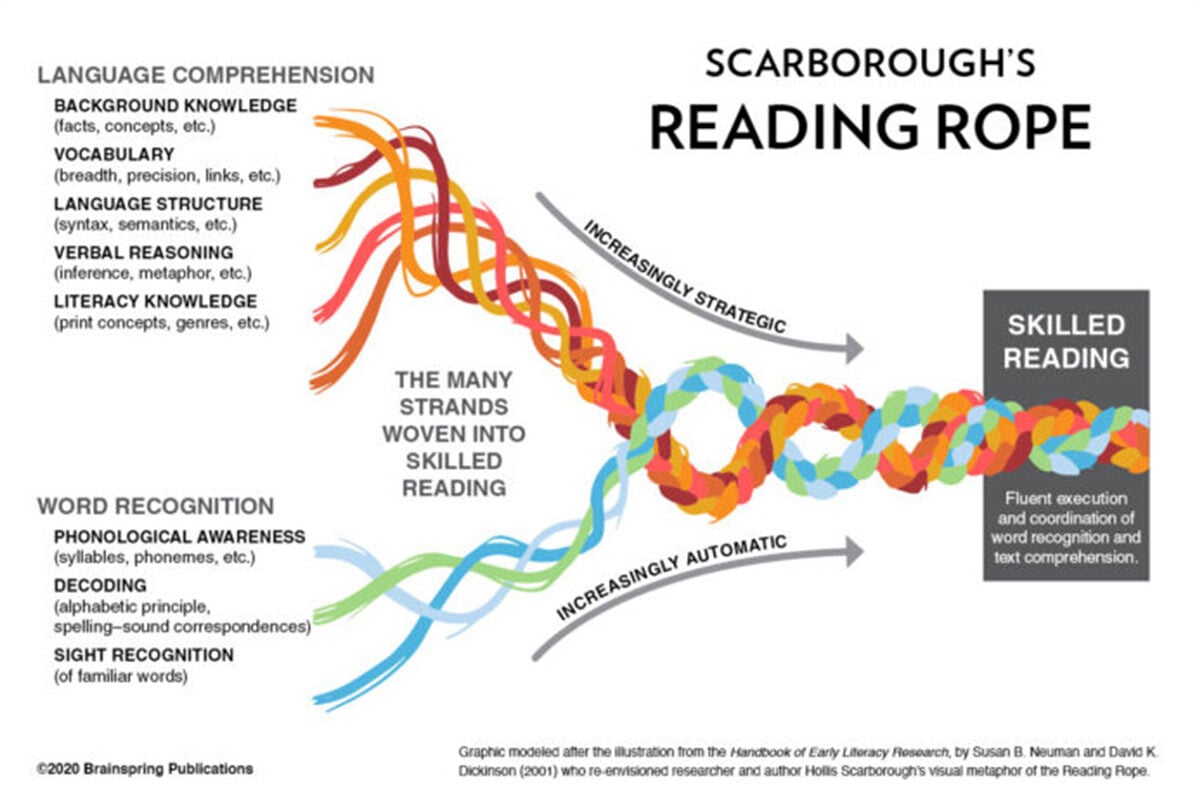Reading research has continued to highlight that the use of balanced literacy techniques are not helpful to children when they are learning to read. Techniques such as the three cueing system and the use of predictable texts that encourage children to ‘guess’ words when learning to read have now been cut from the Foundation Stage of version 9.0 of the Australian curriculum. But, before you go and throw all those home readers in the bin, it’s important to understand why this change has been made, particularly at the Foundation level.
Why are ‘Predictable Texts’ Not Helpful for Early Readers?
When it comes to the beginning stages of a child learning to read, it is important to compartmentalise the different skills you need to explicitly teach. To help explain the different skills required of a skilled reader, Scarborough’s Reading Rope is often used.
This diagram helps us to understand why it is important that in the early stages, each skill is explicitly taught. It also helps us understand why decodable texts, for the purposes of decoding skills and sight recognition, are much more beneficial than the traditional ‘predictable’ and ‘repetitive’ style texts sent home for young readers.
Source: Brainspring
What is a Predictable Text?
Predictable texts were constructed to encourage beginning readers to memorise whole words and sentences, as well as use the picture cues to read any unknown words. The books will often have a repeated sentence on each page with one word that has been changed. Each sentence is accompanied by a picture which will hold a clue for the unknown word.
For example:
- I can see an alligator.
- I can see an elephant.
- I can see an ostrich.
The problem with these texts, for the purposes of teaching children how to decode, is that while the sentences are simple, they often contain words that students are unlikely to be able to decode in the beginning stages of a phonics program. Teaching students to rely on repetition and use the picture to ‘guess’ the word are not helpful reading strategies we should be teaching our young readers.

The example above shows the repetitive sentence with one word being changed. But, with the letter-sound knowledge young readers have at the beginning stages of reading – it’s impossible for them to be able to decode words such as rocket and spaceship without knowing some of those digraphs present.
What Texts Should I Use to Support Beginning Reading Development?
If you are teaching children that are entering the alphabetic stage of reading, they will benefit from reading texts that support decoding as a strategy for reading. Experts discuss how decodable texts have a specific purpose: to scaffold children’s mastery and application of the alphabetic code in reading.
Decodable texts contain a high percentage of words that use the GPCs (grapheme-phoneme correspondences) that students have been taught. As students learn more letter-sound relationships, they can read decodable texts of greater complexity.
Here’s an example of some decodable texts. These texts focus on the five short vowel sounds. All the words used in the text (apart from the tricky words) are decodable and use single grapheme letter-sound correspondences.
Other decodable texts available:
- Single Graphemes Decodable Texts
- Common Consonant Digraphs Texts Set 1
- Common Consonant Digraphs Texts Set 2
What Reading Strategies are Helpful to Early Readers?
- Use a finger to segment the word into sounds, syllables or chunks.
- Go to each grapheme, say the sound.
- Blend the sounds together.
- Check for meaning.
You might like to check out our free download Science of Reading Decoding Strategies bookmarks to help guide these reading strateges.
Yes, Pictures in Stories are Still Important!
Many teachers have expressed concern that this push towards decodable texts and not using the three cueing system is completely disregarding the use of images in stories. Which it’s not.
When using Scarborough’s Reading Rope, you can clearly see that language comprehension, including print concepts such as images, and word recognition eventually work together to develop skilled readers. Educators intertwine the teaching of these skills in a way that suits the needs of their students. At the start of a young reader’s journey, these skills are best taught separately. Why?
In a recent Instagram post by our friend Tam from @misslearningbee she explains this really well:
“Most kids do not have the cognitive room to apply both these skills simultaneously when they are first learning how to read. Teach word recognition skills with explicit phonics lessons and activities. Teach language comprehension skills through exposure to rich texts during read-alouds and other whole class lessons.”
Therefore, using decodable texts and appropriate reading strategies to aid your phonics program is much more beneficial when teaching word recognition skills.









Comments